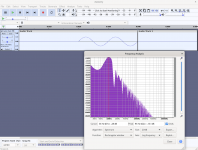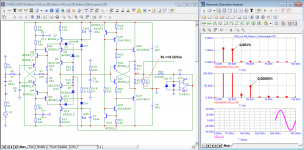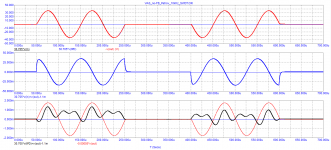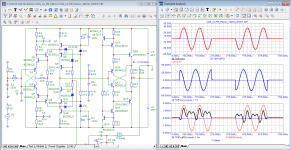Those overshoots and response delays are well understood and well below the threshold of human hearing. Or, put another way, the frequencies (or 1/f if you prefer to talk time) at which these phenomena occur well above the upper limit of the ear’s range.
To argue otherwise is like saying we have to fix the problem of gravity in order for planes to fly better.
Physical constraints say there will always be phase lag around an amplifier loop, there will be a small delay (10-20 ns) and in class AB amplifiers some artefacts caused by the output devices switching on and off. The job of engineering is to deal with these issues so they are no longer of practical significance so we can then enjoy the music.
To argue otherwise is like saying we have to fix the problem of gravity in order for planes to fly better.
Physical constraints say there will always be phase lag around an amplifier loop, there will be a small delay (10-20 ns) and in class AB amplifiers some artefacts caused by the output devices switching on and off. The job of engineering is to deal with these issues so they are no longer of practical significance so we can then enjoy the music.
Petr, try recreating that stimulus signal in audio software such as Audacity, and have a look at the FFT results. You are basically sneaking a broad-spectrum impulse or step function at the beginning and end, and claiming that it is a sine wave. It is not. Your "10kHz" wave most definitely contains harmonics that are 100s of kHz.
so show me these hundred kHz harmonics up to 1%Petr, try recreating that stimulus signal in audio software such as Audacity, and have a look at the FFT results. You are basically sneaking a broad-spectrum impulse or step function at the beginning and end, and claiming that it is a sine wave. It is not. Your "10kHz" wave most definitely contains harmonics that are 100s of kHz.
Fine. Then explain to me why this is happening.
I apply the same test signal to the inputs of different amplifiers. But at the outputs of some amplifiers there is nothing but non-linear distortions, while at the outputs of others additional distortions of up to 1% or more appear.
Last edited:
very few people have solved this problem, mainly those who refused to use negative feedbackPhysical constraints say there will always be phase lag around an amplifier loop, there will be a small delay (10-20 ns) and in class AB amplifiers some artefacts caused by the output devices switching on and off. The job of engineering is to deal with these issues so they are no longer of practical significance so we can then enjoy the music.
Fine. Then explain to me why this is happening.
I apply the same test signal to the inputs of different amplifiers. But at the outputs of some amplifiers there is nothing but non-linear distortions, while at the outputs of others additional distortions of up to 1% or more appear.
Last edited:
Bonsai, so that this is an argument, and not empty chatter, show me the circuit of your amplifier in which the Group Delay is 20 nsPhysical constraints say there will always be phase lag around an amplifier loop, there will be a small delay (10-20 ns) and in class AB amplifiers some artefacts caused by the output devices switching on and off. The job of engineering is to deal with these issues so they are no longer of practical significance so we can then enjoy the music. We know how to make amplifiers with vanishingly low levels of distortion.
Well your conclusion is probably correct, that it's the NFB. The stimulus simply 'forces' the same issues that would occur with harmonics. At a certain high frequency the NFB lags so much that it becomes positive feedback, reducing stability. Maintaining stability seems to be a game of ensuring that the gain in the unstable region is below 1, but there's still the issue of IMD turning ultra-sonic harmonics into audio-correlated noise.so show me these hundred kHz harmonics up to 1%
Fine. Then explain to me why this is happening.
I apply the same test signal to the inputs of different amplifiers. But at the outputs of some amplifiers there is nothing but non-linear distortions, while at the outputs of others additional distortions of up to 1% or more appear.
Attachments
There is a paper by Tomlinson Holman dating back to 1976 in which he quotes the old German DIN standard for group delay audibility vs frequency. In his particular case, he was focused on vinyl reproduction and the RIAA EQ circuit (the DIN spec was for the general case), but nevertheless the principle applies to amplifier circuits without any frequency shaping. A 20ns GD is absolutely inaudible and most amplifiers will be sub 1us - still inaudible.Bonsai, so that this is an argument, and not empty chatter, show me the circuit of your amplifier in which the Group Delay is 20 ns
Why do you focus on things that are of no real consequence in modern amplifiers, given all we know about this stuff and the behaviour of real world signals. No source signal has infinite bandwidth - even Baxandall pointed this out wrt to noise. There comes a point in which the capacitance of the system used to measure the noise and the source impedance limits the measurement bandwidth. This is pure physics and nothing to do with amplifiers or 1st cycle distortion.
Bonsai, you are avoiding presenting a specific argument - namely, your amplifier circuit with group delay = 20 ns.There is a paper by Tomlinson Holman dating back to 1976 in which he quotes the old German DIN standard for group delay audibility vs frequency. In his particular case, he was focused on vinyl reproduction and the RIAA EQ circuit (the DIN spec was for the general case), but nevertheless the principle applies to amplifier circuits without any frequency shaping. A 20ns GD is absolutely inaudible and most amplifiers will be sub 1us - still inaudible.
Using simulators is a great way to be exposed to lies,
-Chris
I absolutely agree with you, as well as prove the truth!
Here is the voltage amplifier test. Figure 01 shows the spectrum of a 10 kHz signal in steady state. The other two figures show a 10 kHz burst test (SWDT).
Select distortion products in any figure that are not related to its spectrum at the output of the amplifier in steady state
Attachments
No source signal has infinite bandwidth
Bonsai, no signal has bandwidth. The concept of bandwidth applies to amplifiers, not to signals. I'm beginning to doubt that you have anything to do with amplifier design.
Bonsai, no signal has bandwidth. The concept of bandwidth applies to amplifiers, not to signals.
indeed, there is something to think about.
The signal has spectrum, but not bandwidth.
A pure sine wave consists of only one harmonic.
The distortion products at the amplifier output are often measured up to 80 kHz. Although there can also be a lot of harmonics above this band.
Above, I gave examples of measuring distortion products from Douglas Self's book in a band up to 500 kHz.
The signal has spectrum, but not bandwidth.
A pure sine wave consists of only one harmonic.
The distortion products at the amplifier output are often measured up to 80 kHz. Although there can also be a lot of harmonics above this band.
Above, I gave examples of measuring distortion products from Douglas Self's book in a band up to 500 kHz.
Simulations and real world differ. Petrov does not measure anything.
Here is my A class amplifier measured with 20 kHz 5 Vrms to 8Ω load, for that alleged ‘speed distortion’. Yellow trace is input and blue trace is output. At first screen, both probes are connected to input to confirm proper measurement setup. Purple trace is input to output subtraction result.

Second screen is where CH2 probe is moved to the amplifier output. We can see that amplifier has some 15 ns propagation delay. Only existing signal deviation is long exactly as is amplifier rise time of some 250 ns. Not by accident.

Here is my A class amplifier measured with 20 kHz 5 Vrms to 8Ω load, for that alleged ‘speed distortion’. Yellow trace is input and blue trace is output. At first screen, both probes are connected to input to confirm proper measurement setup. Purple trace is input to output subtraction result.
Second screen is where CH2 probe is moved to the amplifier output. We can see that amplifier has some 15 ns propagation delay. Only existing signal deviation is long exactly as is amplifier rise time of some 250 ns. Not by accident.
I’m not interested in simulated results or to pursue that discussion.
Why don’t you open your own thread for presenting ideas, instead of hijacking other member’s threads with off-topic content? Ah yes, I get it. No one would join discussion.
So far you have littered over 20 different threads with the same unaccepted claims. Stop doing that, please.
Why don’t you open your own thread for presenting ideas, instead of hijacking other member’s threads with off-topic content? Ah yes, I get it. No one would join discussion.
So far you have littered over 20 different threads with the same unaccepted claims. Stop doing that, please.
My amplifiers all have group delays of 150 to 500ns. Are you now going to tell me (and all the other designers in the forum) their efforts are sub-par because of this?Bonsai, you are avoiding presenting a specific argument - namely, your amplifier circuit with group delay = 20 ns.
There are no infinite bandwidth signals or amplifiers. Even white noise can never be ‘infinite bandwidth’.tombo56, it was about "signal bandwidth". What is the bandwidth of your signal?
the spectrum of the signal can theoretically be infinite
Please provide a diagram of your amplifier. I'll try to run some tests, then we'll continue the discussion.
- Home
- Amplifiers
- Solid State
- Bob Cordell Interview: Negative Feedback



